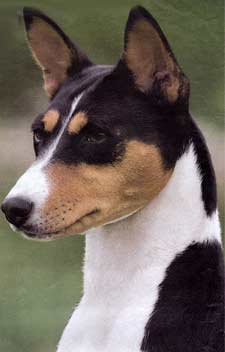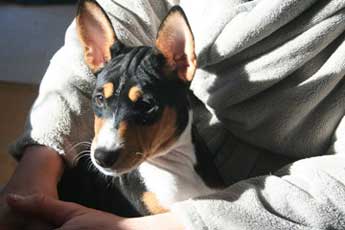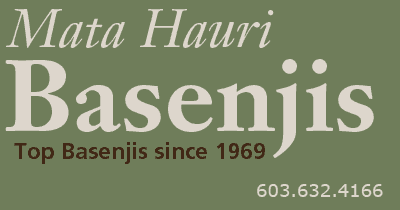
About Basenjis
- So you think you want a Basenji... »
- Nature’s Masterpiece: The Basenji »
- Is a Basenji the Breed for You? »
So you think you want a Basenji...
Because... But...
They don’t bark...
They can and do make a lot of noise. They scream, howl, cry, and yodel. They definitely have a voice.
They are small...
They are a big dog in a small package. They are fast and strong.
They are unusual...
There are more around than you think. Most owners love them too much to let them run loose, and since they do not bark, they can go unnoticed.
They are intelligent...
Basenjis are hounds and were bred to be independent hunters. Very intelligent, they get bored very easily. While entertaining themselves, they can get into lots of trouble.
I saw “Goodbye My Lady” and ...
While the movie is very enjoyable, it is not a good representation of normal Basenji home-life.
If you have read this far, and still want a Basenji, you should consider the following points:
Basenjis are an active, intelligent, demanding dog, requiring your attention most of the time, and your love all of the time. If you are not willing to spend the time and effort to train and enjoy them, then you do not want a Basenji.
Basenjis are affectionate, loving dogs, who will build a strong bond with you and your family. They will, in most cases, be friendly with strangers and follow children anywhere. If you want a one-person dog, you do not want a Basenji.
Basenjis are not guard dogs. However, they are very alert, and will give warning if strangers are around. Though they do not bark, you know by their actions when something is wrong. If you are looking for a guard or great protection dog, you do not want a Basenji.
Basenjis are mischievous and easily bored. It can be a big mistake to leave an untrained Basenji alone in a house. They can be extremely destructive if left to entertain themselves. They should be trained or confined in a suitable crate. If you are not prepared to do this, you do not want a Basenji.
Basenjis love to run and unfortunately they believe they can out-run any danger. They can jump over or climb out of any fence if they so desire. They are very inquisitive, and the grass is always greener etc., so if you like a free-running dog, unsupervised, please do not get a Basenji.
Basenjis are habit-forming, once you have been owned by and loved this intelligent, mischievous, active, independent, loving breed, you may not ever want to be without at least one. When you buy a Basenji, you are making a 10-15 year commitment to him. If you are not ready for this commitment, please do not buy a Basenji.
Basenji owners believe that all dogs should be contained in a yard or kennel run - rather than running loose. Yes, the dog that is contained misses a lot of life’s little pleasures... like being hit by a car; like being dirty and full of burrs; covered with fleas and ticks, and loaded with worms. The joy of fighting with other strays, the pleasure of being sick on garbage, and picking up diseases; and best of all, the thrill of being shot in a farm yard.
If you still believe you want a Basenji and are qualified to be owned by one of those unique little dogs, then welcome to the club. Basenji owners will take great pleasure in welcoming you into a select company of true believers that we own the best, most nearly ideal dog that ever lived, THE BASENJI.
by The Mid-Atlantic Basenji Club
Nature’s Masterpiece: The Basenji

The dogs of the Stone Age were small foxy fellows, who gathered around the first camp fires. As ancient man went from place to place about his business, they followed at a respectful distance probably attracted by occasional handouts, possibly because they felt an affinity to him. The first dogs, according to paleontologists, were very like Basenjis, and there are scientific reasons for supposing that the Basenji was this dog of prehistoric times.
Living in long isolation from the outer world for countless thousand of years in the heart of Africa, the Basenji has not been altered by the demands and whims of man. Nothing about him has changed - neither his size, his shape, the color and texture of his coat, nor his temperament. The Basenji is a well-defined natural breed and is one of Nature’s masterpieces.
The Basenji made an appearance in civilization at the dawn of history as a palace dog of the Pharaohs, so long ago that he watched the Pyramids being built. Pictured in bas-relief and sculptured in stone as far back as 4000 B.C., the Basenji even lent his ears to the dog-headed god Anubia. He was found in Mesopotamia many centuries later. The Metropolitan Museum of Art owns a bronze statue of a man and a Basenji-like dog, including curled tail and wrinkled forehead. This is identified as Babylonian, 1500 B.C.
Ancient empires, crumbled, disappeared. So did the Basenji - and without a trace. The explorer, Merolla, whom Edward C. Ash quotes in “Dogs and Their Development,” caught a glimpse of him in the Congo in 1682. “These dogs, notwithstanding their wildness, do little or no damage to the inhabitants. They are red-haired, have small slender bodies and the tails turned upon their backs.” Only as recently as the latter half of the 19th century were Basenjis re-discovered in their original habitat - the headwaters of both the Nile and the Congo, in the heart of Africa. There the are the hunting dogs of native tribes, and so highly esteemed are they that they are regarded as having equal rights with their masters.
The purebred Basenji is a small dog, the male measuring approximately 17 inches from ground to top of shoulder; the female, 16 inches. The preferred weight for the male is about 24 pounds; the female 22. His legs must be slender and long; his toes highly arched. His movement lends distinction to the man who owns and walks one.
In sunlight he is an arresting sight. His coat is short and silky and one has a choice of colors. There is a lustrous, golden brown with white feet and white tall tip, white chest and belly, and in many specimens, a white blaze and collar. There is a striking black and white edition, glossy black with white where it occurs on the red dogs; and a handsome tri-color edition - glossy black with sharp edgings of brilliant tan, tan triangular eyebrows and cheeks, with white, of course, where it occurs on red dogs. The Basenji tail should curl tightly to one side of his back, and the more animated the dog the tighter the curl. The head and expression of the Basenji are his most appealing features. His prick ears give him a constant look of alertness; his brown eyes have an oriental slant; and his wrinkled forehead imparts an anxious expression to his face - the look of one who, having known man from the beginning, is terribly worried about the outcome.
Since he is silent on the trail, the Congolese, as did the ancients, require him to wear a hunting bell made of wood, or iron, or the shell of a Barassus nut, so that they may trail him to his prey. He will not become hysterical when the door bell or the telephone rings. He will not become vocal at the sight of other animals nor the approaching stranger.
Although some are almost silent, Basenjis possess vocal chords and do have a voice. They have a growl worthy of a dog twice their size; they have a threatening snarl; and they have a scream of terror. Some will talk with their masters and with one another in voices like those of Siamese cats. Others are yodelers, with a range comparable to that of a coloratura, and will even perform on command!
Then there is a call heard generally at night, apparently a pack call. It is an eerie sound, more reminiscent of a bird than an animal. And there is the crow, delightfully like a young rooster’s initial attempt. The Basenji crows when he greets human friends, when he’s surprised, when he’s amused, when he’s achieved a triumph such as charging into the room forbidden to him, or when he is pleased with the way things in general are going. On such occasions he is at his irresistible best.
Owners will testify to his phenomenal intelligence, his inventiveness, his curiosity, and his clownish sense of humor. But keep in mind that since the Basenji usually has a single devotion to one man, one family, one boy or girl, it is preferable that he make friends among the human race early in life.
He is a staunch believer in personal and property rights. The silent hunter is also a silent watch dog. A sound outside brings him noiselessly to the door to await an intruder. He will give the house-breaker a rough time.
The Basenji is immaculate, grooming his coat and paying particular attention to his feet, again like a cat. He takes such good care of himself that he rarely needs a bath. An occasional brisk rub with a rough towel and a daily going-over with a soft brush will delight him and will cause his coat to glisten.
The Basenji is practically odorless. If there is any scent at all, it is reminiscent of clean, dry grass.
Some Basenji bitches will come into season only once a year, usually in the fall, puppies arriving during the holidays. With an eye on her own, Nature has ordained that in climate where there are definite winters and summers, females ought to come in season in the spring, puppies to arrive when the weather is congenial - in June or July. In the Northern United States and Canada as the years pass, more and more litters are arriving in late spring and early summer, so that puppies are now generally available throughout the year.
Although for fifty years the British made many attempts to bring Basenjis into England, they were not successfully acclimated there until 1937. In 1938, they were introduced into the United States and Canada. The Basenji Club of America, Incorporated, an organization of Basenji owners, admirers of the breed, sportsmen, naturalists, writers and breeders, is dedicated to the preservation of the Basenji as an aboriginal dog in the image of its African prototype. Your inquiries regarding the Basenji and membership in the Basenji Club of America, and the Magnolia Basenji Club are welcome, and will be promptly answered.
Author Unknown
Is a Basenji the Breed for You?

Before you decide on a Basenji you need to know the faults as well as the good points. I would say they have four major faults which vary in intensity depending on lines. If you still want a Basenji after reading the faults then you may be a “Basenji person”. Most literature stresses the good points which makes the breed seem almost too good to be true.
- A Basenji is bred to be an independent hunter. This means that it must make its own decisions in the field. What this means to the pet owner is that the Basenji will not walk off leash at its owner’s heels without training and they do not learn invisible yard boundaries. They either need a fenced in yard or they need to be walked in a leash. Some Basenjis seem to resent being tied out but, if it is started when they are young and they are not forced to be tied in the cold, they usually adjust. A Basenji will come when it is called, but frequently not until it is ready. A Basenji is very intelligent and quick at figuring things out but this can work against strict obedience. I always recommend obedience classes and all of my Basenjis have been trained, but if two or three of my Basenjis get out together they run first and come later. A dish of food or an open car door can often make them change their mind.
- Basenjis seem to be more “mouth oriented” than some breeds. As puppies they need to be taught to chew only their own toys and to sleep while their owners are gone. Using a crate during the puppy stage solves this problem. Once the Basenji is an adult, then the crate can be slowly discontinued.
- Another fault is that they can be aggressive with other dogs especially when either dog is on a leash or confined. If they are taught early in life to get along with other dogs, then this terrier-like tendency can be helped. They seem to get along better off leash or on neutral ground. Older Basenjis frequently seem to dislike other older Basenjis of the same sex, but do get along with the opposite sex. If Basenjis are raised together, this is not a problem. Most Basenjis love to play with other breeds of dogs or cats if they are allowed to do so as puppies.
- The last fault is that the Basenji is somewhat catlike in that it likes to be up on things. It is extremely agile very early. I, personally do not consider this a fault because they are so clean I don’t mind them on my furniture and I teach them very early that the table is not to be jumped on for any reason. If the owner doesn’t want the dog on the furniture, it must be taught early and it should also have its own bed or chair that is raised and preferably near a window. Basenjis have a tendency to “worm” their way into their owners’ bed at night so again, the Basenji needs to be taught house rules early.
If you can put up with the above faults then the little Basenji has a wealth of great points! They are barkless, odorless, and virtually shed free so they make wonderfully clean, quiet pets. They adjust easily to apartment or country living. They love to run, but they can adjust quite comfortably to little exercise. They are easy to housebreak and get along well with children. They usually get along well with other household pets, although they might first want to chase them. Once they are taught to be friends, they get along with almost anything. Our Basenjis have been friends to cats, parakeets, rabbits, crows, skunks, raccoons, foxes, squirrels, and other small pet rodents and birds. However, they will still hunt wild ones.
Basenjis can take any kind of climate, but they spend most of our New England winters curled up near the fire or register. They cannot be tied out during cold weather but they can run with the family (ours have gone cross-country skiing and even pulled the children on sleds). Basenjis are great companions and like to do whatever their family does whether it is traveling, camping, boating, or just lying next to a family member on the sofa.
A Basenji will let its family know if an intruder is around, but it cannot scare them off by incessant barking. They have a growl that is quite loud but a Basenji should not be bought only as a watch dog. There are other breeds that probably can do that job better.
The Basenji is a proud elegant little dog that is happy to fit its moods to those he loves. He loves to play, but when the owner is ready to call it quits he is content to lie at the feet of his master just as in Ancient Egypt.
Mata Hauri Basenjis

